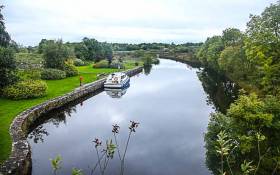Displaying items by tag: shannon cruiser
Will Heritage Bill Destroy Navigations it Should be Protecting? – IWAI
The Inland Waterways Association of Ireland (IWAI) will appear today before the Joint Oireachtas Committee on Culture Heritage and the Gaeltacht which is examining the Heritage Bill 2016 Part 2 Canals. In a long running campaign, the IWAI will be calling for legislation that puts user requirements, tourism development and local communities at the centre of the regulations.
'How ironic it would be that a Heritage Bill rather than protecting the future of the Grand and Royal Canals and the Barrow Navigation enables legislation for Bye-laws that end up creating waterways with no boats on them' says John Dolan of the IWAI.
On Tuesday December 5th the Inland Waterways Association of Ireland (IWAI) will appear before the Joint Committee on Culture, Heritage and the Gaeltacht which is examining the Heritage Bill 2016 Part 2 Canals. The is renewing its call to elected representatives to support the IWAI campaign for further revision to the proposed legislation.
The main areas of concern relate to
- • new complicated legal licensing, - rather than the need to legislate for a simple permitting system that is customer friendly, easy to use, and fit for purpose
• Adequate provisions - so that boats of dimensions for which the canals were built to accommodate are protected and can continue to do so into the future
• appropriate charging structures - that matches the provision of services available
• fixed payment notices and fines with no independent appeal mechanism other than the courts, that will not encourage use of the canals and are not in place on the other Irish inland waterways
• proposed provision and powers of Authorised Officers
• legislation that will facilitate the introduction of a complete different set of rules, charges, regulations and fines that are not in place on the adjoining Waterways, and will make these canals less attractive to potential boating tourism
Ireland’s canals as beautiful linear waterways have the potential to attract both domestic and International boating visitors who will relish the tranquil opportunity of slow tourism cruising at walking pace as people move faster than the canal boats on the system, while experiencing the associated industrial heritage, peat lands, small villages and towns that have interdependence with the canals and our capital city.
To achieve this potential it is vital that the Heritage Bill 2016 preserves and enables the development of the canals for the current and future generations and communities. Over regulation and excessive charges are not the answer to developing these waterways, they deserve proper legislation that put user requirements, local communities and tourism at the centre of the regulations.
Shannon Cruiser Crash
A man at the upper controls of a cruiser on the inland waterways jumped to safety just before his vessel hit a bridge in Co Tipperary on Friday last.
The man was believed to be attempting to moor the vessel close to the bridge at Ballina on the Shannon when he lost control. The boat hit one of the bridge arches causing extensive damage to the boat’s upper-level console. It is believed that only for the water level at the time and his quick actions he could have been seriously injured.
There were six people on board the vessel all of whom were in the lower deck and uninjured.
The incident was witnessed by a member of the Killaloe unit of the Irish Coast Guard, who raised the alarm. Rescuers went to the scene and discovered that the cruiser had been extensively damaged.






























































